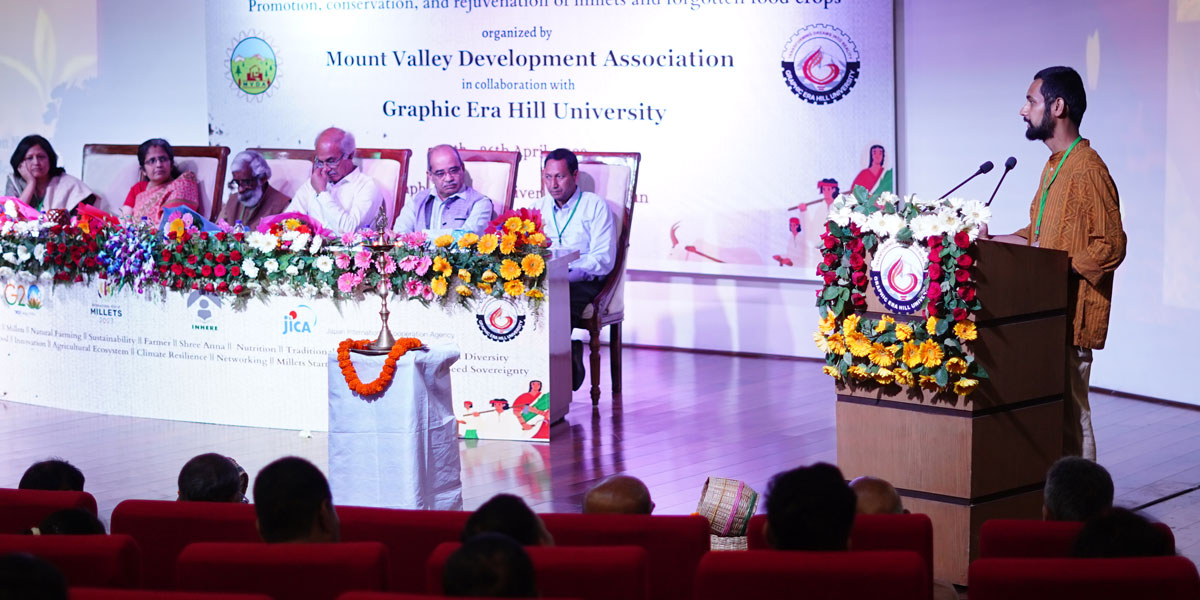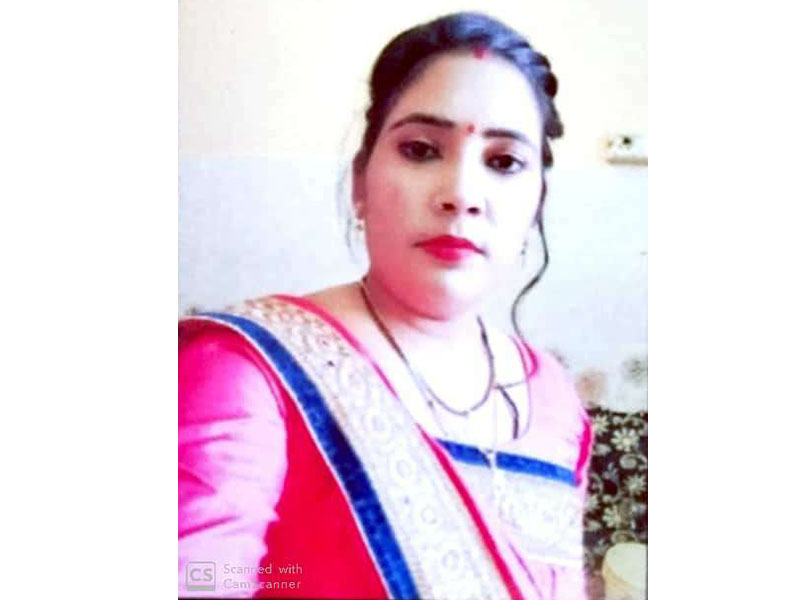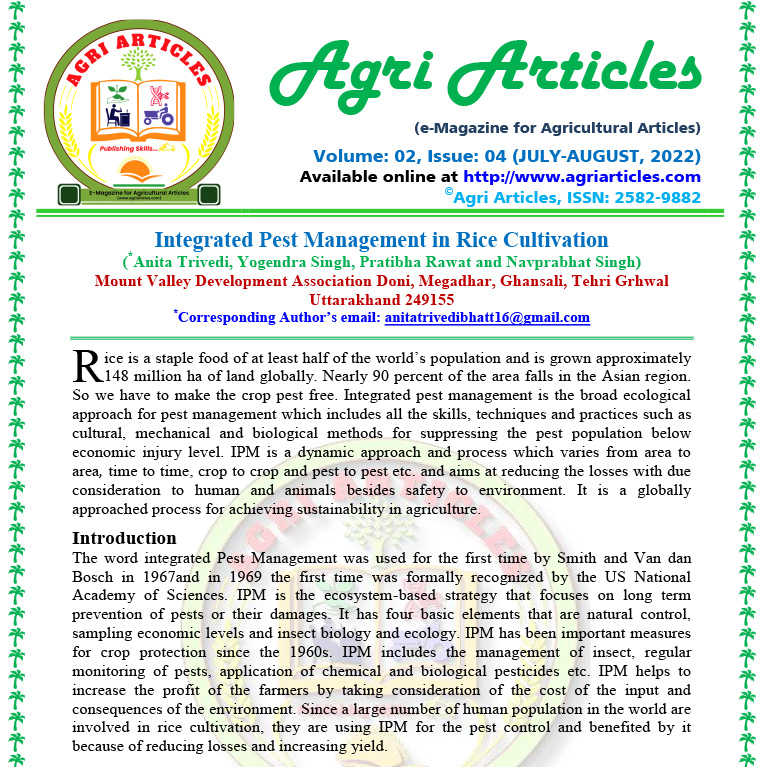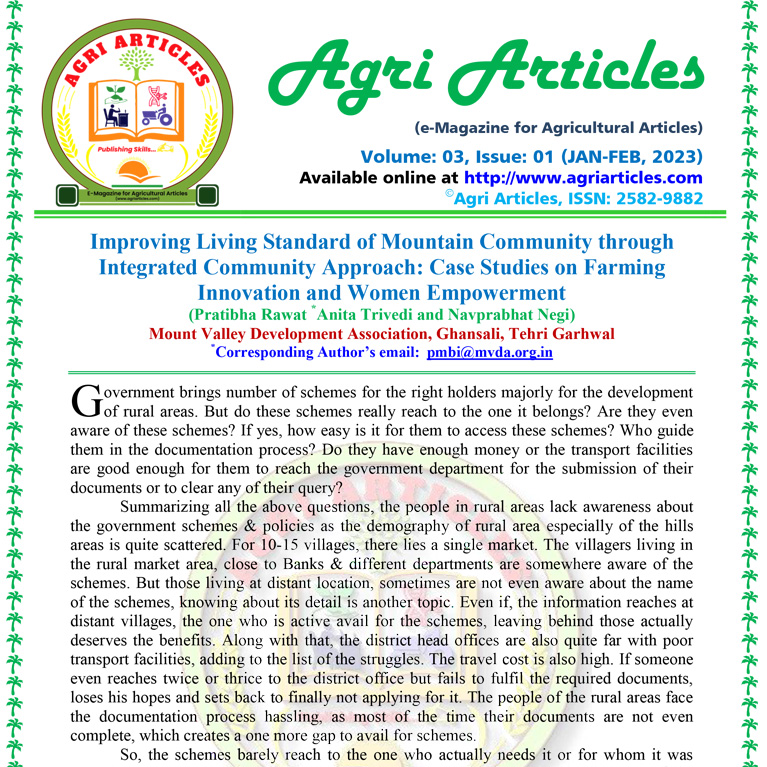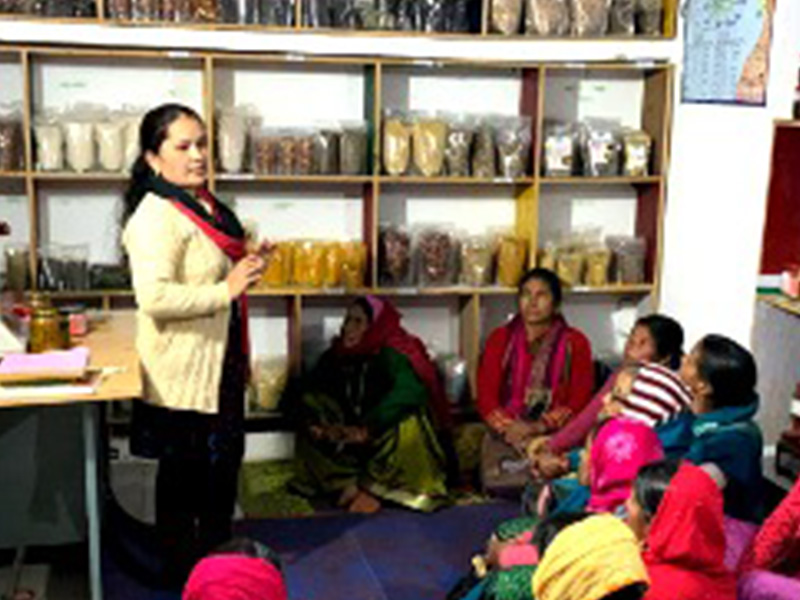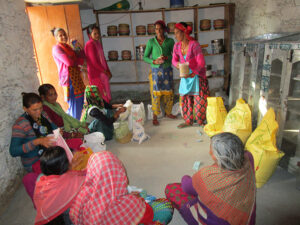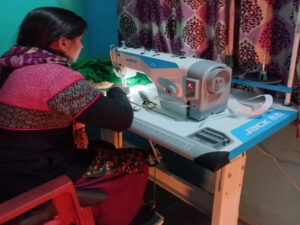अन्तर्राष्ट्रीय बीज दिवस के अवसर पर माउंट वैली डेवलपमेंट एसोसियशन और ग्राफिक ईरा हिल विश्वविद्यालय के संयुक्त तत्वाधन में परम्परागत कृषि और जैव विविधता विषय को लेकर दो दिवसीय सेमीनार का आयोजन किया गया है। इस दौरान किसानों महिलाओं, शोधकर्ताओं, छात्रो, उद्यमियों और उपभोक्ताओं सहित अनेक हितधारको को एक दूसरे से सीखने, टिकाउ एवं सतत कृषि के लिए नये नये नवाचरो के आदान प्रदान पर वृहद चर्चा हुई है। विशेषज्ञो ने कहा कि स्वस्थ स्वास्थ्य के लिए मोटे अनाज ही आज की आवश्यकता है। इसलिए हिमायल जैसे राज्यों में प्रकृति आधारित और परम्परागत कृषि को बढावा दिया जाना चाहिए। मिलेट्स वर्ष में यह कार्य नियमित हो जाना चाहिए।
दो दिवसीय सेमीनार के दौरान चर्चा के मुख्य बिंदुओ में परम्परागत बीज, कृषि, जैव विविधता को बढाना, जलवायु के अनकूल फसलो को उगाना, मिटटी सहित प्राकृतिक संसाधनो के सामजस्य बाबत उत्पादकता को बढाने पर विचार विर्मश किया गया है। महिलाओं ने सवाल उठाया कि उतराखण्ड में कृषि की जमीन सर्वाधिक बिकने की कगार पर आ चुकी है। यह बात भी खुलकर सामने आई कि परम्परागत बीज भी परम्परागत खेती और मोटे अनाज को विकसित करने और उत्पादकता क्षमता बढाने के लिए आवश्यक है। प्रश्न आया कि मोटे अनाजो के लिए बाजार आज भी सुलभ नहीं हैं।
इस दौरान बायोडायवर्सिटी कन्वेंशन सीड, सॉइल एंड मिलेट्स विषय पर बीज बचाओ आन्दोलन के प्रणेता विजय जड़धारी ने कहा कि आज अब आवश्यकता हो गई है मोटे अनाज के संरक्षण की। दुनियाभर में मोटे अनाज को बचाने के लिए लोग आगे आ रहे है। यही मांग वे वर्षो से कर रहे थे। स्वस्थ स्वास्थ्य के लिए मोटे अनाज का भोजन ही अनिवार्य है। इससे आगे परमपरागत बीज को संरक्षण करने की प्रबल आवश्यकता है। उनके पास उतराखण्ड के सैकड़ो परम्परागत बीज संरक्षित है। मगर सभी के घर में बीज संरक्षित हो तब जाकर हम किसी सफलता तक पंहुच पायेंगे। बतौर मुख्य अतिथि श्री जड़धारी ने कहा कि खेती व्यापार नहीं हमारी संस्कृति हैं। पुराने बीजों को बचाना एक चुनौती है। बीजों का भी अपना वंश होता है, उसे उजाड़ना एक अपराध है। कहा कि कोरोना ने लोगों को कृषि और मिलेट्स की अहमियत बता दी है। उन्होंने कहा कि मिलट्स पौष्टिक होने के साथ इम्यूनिटी बढ़ाने के लिए बेहतरीन हैं। उन्होंने कहा कि उत्तराखंड में जंगली जानवर और मौसम खेती के सबसे बड़े दुश्मन हैं और सरकार को इसके लिए कुछ कदम उठाने चाहिए। बीजों की मूल वैरायटी बहुत शक्तिशाली होती हैं। किसी भी तरीके के बदलाव को यह सह सकती हैं। उन्होंने शंका जाहीर की है कि बीजों के जीनोम में बदलाव करके वैज्ञानिक कंपनियां हमें हाइब्रिड बीजों का गुलाम बना रहीं हैं।
हिमाचल प्रदेश से आये पद्मश्री नेकराम शर्मा ने कहा कि हिमाचल और उतराखण्ड का भूगोल एक जैसा ही इसलिए यहां पर कृषि और अन्य फसलो के लिए सरकारो को खास योजना बनानी चाहिए। उन्होने कहा कि हिमालय राज्यों की परम्परागत खेती की आज आवश्यकता बढ रही है, यही सुखद है। पहाड़ पर जंगली जानवरो का जो खतरा है उससे निपटने के लिए भी परम्परागत तौर तरिके है। अर्थात परम्परागत खेती और बीज के लिए ही अनिवार्य योजना बनाई जाये। जिसे बाजार से भी जोड़ा जाये। उन्होने कहा कि वे वर्षो से परम्परागत खेती करते आये है। कई बार उनकी मजाक उड़ाई गई मगर वे अपने मिशन पर जुड़े रहे। आज सरकार और स्थानीय किसान उनकी परम्परागत कृषि का अनुसरण कर रहे है। उन्होने खुद का सफल उदाहरण दिया कि उनके अनार के बगीचे में जो कीट पैदा होते है उनसे अनार को बचाने के लिए वे प्राकृतिक साध नही उपयोग मे लाते है। वे कभी भी कीटनाशक चीजो को इस्तेमाल नही करते हैं।
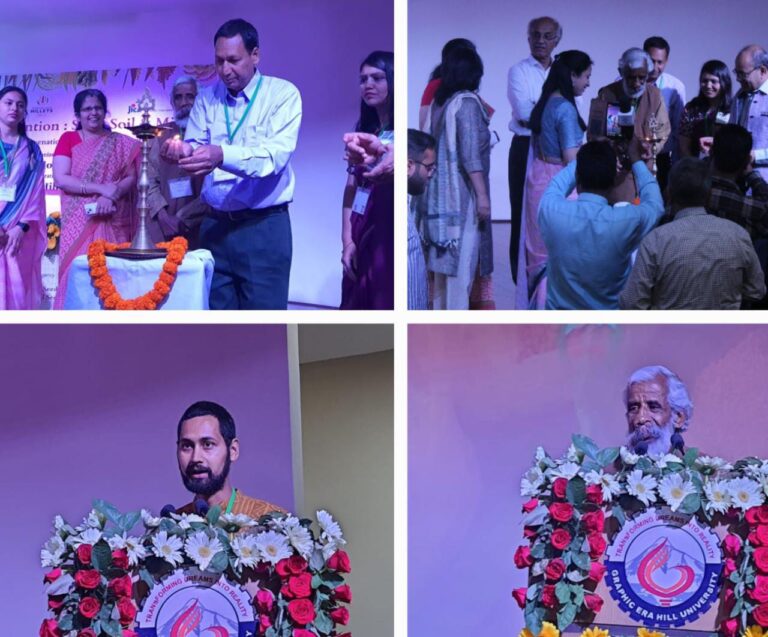
पद्श्री कल्याण सिंह रावत ने कहा कि उतराखण्ड में प्राकृतिक खेती होती आई है। हरित क्रान्ती के आने के बाद देश के किसानो की परम्परागत खेती में बिखराव आया है। इसलिए लोगों को फिर से प्राकृतिक खेती की ओर लौटना पड़ेगा। यहीं से मोटे अनाजो के संरक्षण की शुरूआत होती है। ग्राफिक ईरा विश्वविद्यालय के एसोसिएट डीन एग्रीकल्चर प्रो0 वाई. पी. सिंह, वन्य आर्गेनिक से सुप्रिया, रूद्र एग्रो स्वायत सहकारिता के प्रमुख नरेश नौटियाल, कृषि परामर्शदाता कुलदीप उनियाल, समाजिक कार्यकर्ता समीर रतूड़ी, एससीएच कन्सलटिंग के अरविन्द रावत, त्रिशूली प्रड्यूशर कम्पनी की जगदीश जोशी, माउन्ट वैली डेवलपमेंट एसोसियशन के संस्थापक अवतार नेगी, श्रमयोग संस्था के अजय जोशी, पीएसआई के पूरण बर्त्वाल, डा0 विनोद भट्ट आदि विशेषज्ञो ने अपने विचार व्यक्त किये।
माउंटे वैली डेवलपमेंट ऐशोसियशन के समन्वयक नवप्रभात ने बताया कि बीज हमारी सांस्कृतिक विरासत है। इसे बचाने के लिए हम सभी को मिलकर परंपरागत बीज सरंक्षण के लिए अपने अपने स्तर पर कार्य करना होगा। साथ ही समुदाय व विभिन्न हितधाराको के लिए आवश्यक सुविधा बढ़ने में संयुक्त प्रयास करने होंगे। इस सेमिनार में ऐसे संयुक्त नेटवर्किंग के लिए कार्ययोजना बनानी है। आई एम आई की कोषाध्यक्ष बिनीता शाह ने कहा कि उत्तराखंड में मिट्टी, बीज और मिलेट्स का संरक्षण पर्वतीय क्षेत्रों के विकास का आधार है। जरूरत है कि हम मडुवा जैसे एक अनाज पर नहीं बल्की हर तरह की मलेट्स पर ध्यान दें। विश्वविद्यालय के प्रो. चांसलर डॉ. जे. कुमार ने कहा कि ग्राफिक एरा हिल यूनिवर्सिटी में 2017 में शुरू हुआ स्कूल ऑफ एग्रीकल्चर रिसर्च किसानों की समस्याओं के समाधान ढूंढने का काम भी करता आया है। कृषि के क्षेत्र में स्टार्टअप्स की जरूरत है। उत्तराखंड की पारंपरिक बारह अनाजा कृषि पद्वत्ति के बारे में बताते हुए उन्होंने कहा कि हमारे पूर्वज मिट्टी की फर्टिलिटी की अहमियत जानते थे। हमें इस धरोहर को आगे ले जाना है। माउंट वैली डेवलपमेंट अथॉरिटी के श्री नवप्रभात ने समेल्लन के उद्देश्य और महत्व पर प्रकाश डाला। विश्वविद्यालय के डायरेक्टर जनरल डॉ. एच. एन. नागराजा, वाइस चांसलर डॉ. आर. गौरी कार्यक्रम में उपस्थित रहे। सेमीनार के प्रथम दिवस का संचालन डॉ. हिमानी बिंजोला, द्वीतिय दिवस का संचालन ऋतु सोघानी ने किया है।

